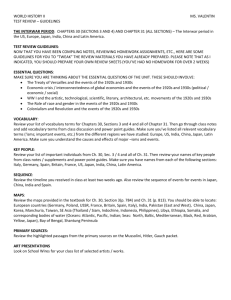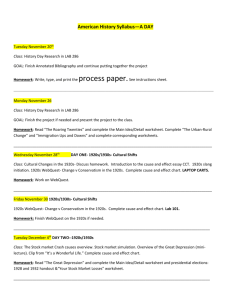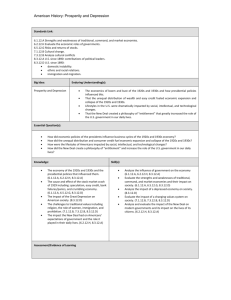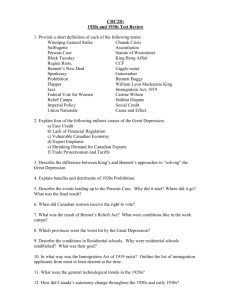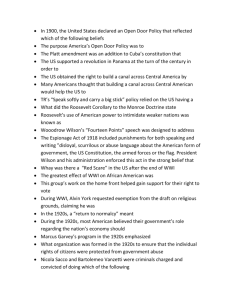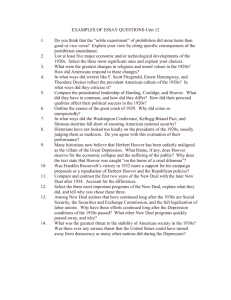DOC
advertisement
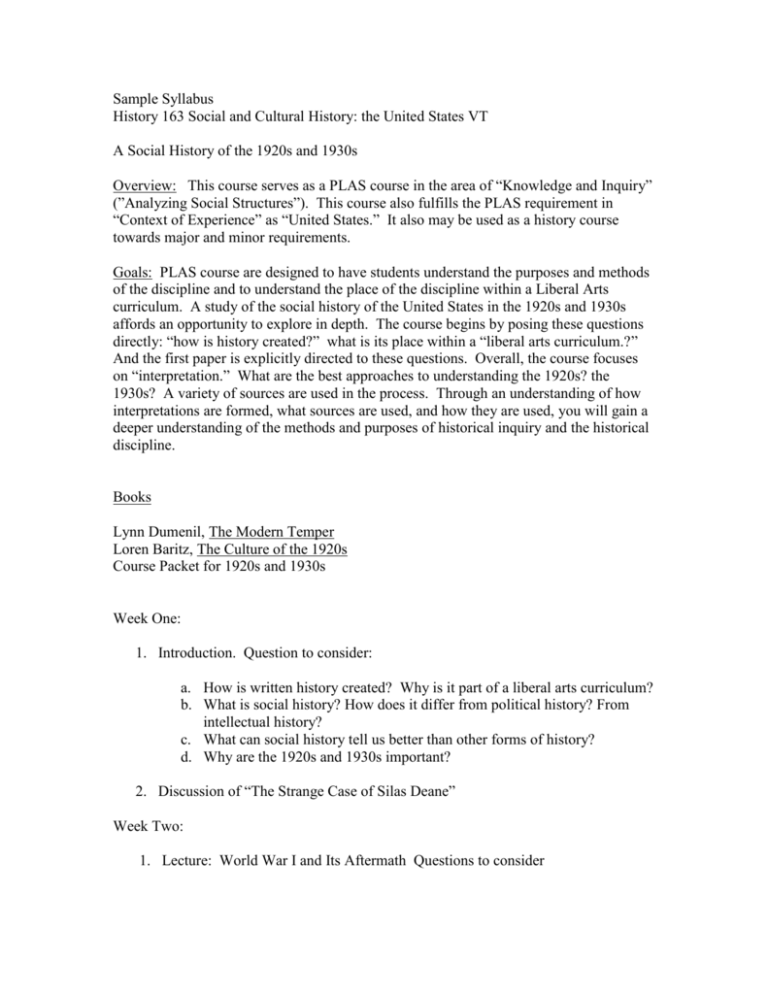
Sample Syllabus History 163 Social and Cultural History: the United States VT A Social History of the 1920s and 1930s Overview: This course serves as a PLAS course in the area of “Knowledge and Inquiry” (”Analyzing Social Structures”). This course also fulfills the PLAS requirement in “Context of Experience” as “United States.” It also may be used as a history course towards major and minor requirements. Goals: PLAS course are designed to have students understand the purposes and methods of the discipline and to understand the place of the discipline within a Liberal Arts curriculum. A study of the social history of the United States in the 1920s and 1930s affords an opportunity to explore in depth. The course begins by posing these questions directly: “how is history created?” what is its place within a “liberal arts curriculum.?” And the first paper is explicitly directed to these questions. Overall, the course focuses on “interpretation.” What are the best approaches to understanding the 1920s? the 1930s? A variety of sources are used in the process. Through an understanding of how interpretations are formed, what sources are used, and how they are used, you will gain a deeper understanding of the methods and purposes of historical inquiry and the historical discipline. Books Lynn Dumenil, The Modern Temper Loren Baritz, The Culture of the 1920s Course Packet for 1920s and 1930s Week One: 1. Introduction. Question to consider: a. How is written history created? Why is it part of a liberal arts curriculum? b. What is social history? How does it differ from political history? From intellectual history? c. What can social history tell us better than other forms of history? d. Why are the 1920s and 1930s important? 2. Discussion of “The Strange Case of Silas Deane” Week Two: 1. Lecture: World War I and Its Aftermath Questions to consider a. Are the writings of intellectual representative of public opinion? b. Is World War I the best way to explain the social history of the 1920s? 2. Discussion: Selections from John Dos Passos, e.e. cummings, Ernest Hemingway, and Thorsten Veblen in Baritz, The Culture of the Twenties Week Three: 1. Lecture: The Red Scare, Immigration Restriction, the Rise of the Ku Klux Klan, Prohibition, Fundamentalism Questions to consider a. On the basis of these developments, can we label the 1920s a conservative decade socially? b. Are the causes of these developments located in the reaction to World War I or in longer term causes? 2. Discussion” Selections from A. Mitchell Palmer, Hiram Evans, Clarence Darrow, William Jennings Bryan, and W.B. Riley in Baritz Week Four: 1. Lecture: Consumerism Questions to consider a. What is the difference between a production-oriented capitalism and a consumer-oriented capitalism? b. When did consumerism start? Does it remain consistent? How does it change? Why? c. How does consumerism impact various areas of society? Production? Religion? Sports? 2. Discussion: Selections from Sinclair Lewis and Bruce Barton, articles by Warren Susman, and first paper on advertising Week Five: 1. Lecture: The “New Morality” Questions to consider: a. What is the “new morality?” b. How prevalent is it? c. What was the main cause? World War I? Consumerism? 2.Discussion: Selections from Frederick Lewis Allen, Only Yesterday and F. Scott Fitzgerald article in Epilogue of Baritz Week Six: 1. Lecture: Radio and Film Watch “The It Girl” Questions: a. How do radio and film contribute to a “national culture?” b. Is popular culture a democratic culture? c. What is the message of the film? 2.Discussion: Of Film “The It Girl” Week Seven: 1. Lecture: The literary scene: Fitzgerald, Hemingway, The Lost Generation, the Harlem Renaissance, Sinclair Lewis Questions to consider: a. When we study these literary figures, are we studying intellectual history or social history—or both? What does this tell us about the categories of history? 2. Discussion of first paper: A comparison of Lynn Dumenil and Frederick Lewis Allen Questions to consider: a. In light of the Silas Dean article, how would you evaluate the “selection” of both authors? Are their methods of “selection” similar to or different from other disciplines in the Liberal nArts. b. In your mind, which author gives you a more accurate picture of the 1920s? Does this mean the other author is inaccurate? Week Eight: 1. Lecture: The Thirties and the Depression Questions to consider: a. Are the two decades in direct contrast to each other? Does anything carry over? Impact of World War I? Consumerism? What changes significantly? What does not? 2. Discussion: Selections from Studs Terkel Week Eight: 1. Lecture: The Radical Thirties Questions to consider: a. Was the joining of various radical organizations only a sign of radicalized politics? b. Has the amount of radicalism been exaggerated? 3. Discussion: Article by Warren Susman, selections from Huey Long Week Nine: 1.Lecture: The literature of the thirties, the “documentary style,” social realism, proletarian literature, the WPA Questions to consider: a. What are the strengths and weaknesses of these styles? Do they connect in any way with how history is created? b. Were these the only styles of the thirties? Were the other styles escapist? Or were they connected to the thirties? 3. Discussions: Odets, Waiting for Lefty Week Ten and Eleven” 1. Lecture: Film Styles of the 1930s: Gangster Films, Musicals, Social Realism Questions to Consider a. What do each of these styles tell us about the social history of the 1930s? b. Are the gangster films about the 1920s or 1930s? Does this issue ever come up about the writing of history? c. Are the musicals escapists? d. Are the social realist films radicals? 2, 1, and 2 Watch Grapes of Wrath. Bug Berkeley, and Gangster Film Week Twelve: 1. Discussion: Three Films 2. Lecture Week Thirteen: Labor Struggles 1. Film: With Babies and Banners 2. Discussion Week Fourteen: Summary Second Paper on Interpreting the 1930s due. Final Examination
